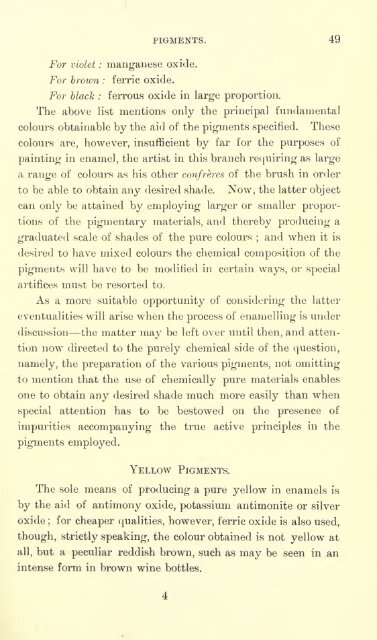Enamels and enamelling; an introduction to the preparation and ...
Enamels and enamelling; an introduction to the preparation and ...
Enamels and enamelling; an introduction to the preparation and ...
You also want an ePaper? Increase the reach of your titles
YUMPU automatically turns print PDFs into web optimized ePapers that Google loves.
For violet : m<strong>an</strong>g<strong>an</strong>ese oxide.<br />
For brown : ferric oxide.<br />
PIGMENTS. 49<br />
For black : ferrous oxide in large proportion.<br />
The above list mentions only <strong>the</strong> principal fundamental<br />
colours obtainable by <strong>the</strong> aid of <strong>the</strong> pigments specified. These<br />
colours are, however, insufficient by far for <strong>the</strong> purposes of<br />
painting in enamel, <strong>the</strong> artist in this br<strong>an</strong>ch requiring as large<br />
a r<strong>an</strong>ge of colours as his o<strong>the</strong>r confreres of <strong>the</strong> brush in order<br />
<strong>to</strong> be able <strong>to</strong> obtain <strong>an</strong>y desired shade. Now, <strong>the</strong> latter object<br />
c<strong>an</strong> only be attained by employing larger or smaller propor-<br />
tions of <strong>the</strong> pigmentary materials, <strong><strong>an</strong>d</strong> <strong>the</strong>reby producing a<br />
graduated scale of shades of <strong>the</strong> pure colours ; <strong><strong>an</strong>d</strong> when it is<br />
desired <strong>to</strong> have mixed colours <strong>the</strong> chemical composition of <strong>the</strong><br />
pigments will have <strong>to</strong> be modified in certain ways, or special<br />
artifices must be resorted <strong>to</strong>.<br />
As a more suitable opportunity of considering <strong>the</strong> latter<br />
eventualities will arise when <strong>the</strong> process of <strong>enamelling</strong> is under<br />
discussion <strong>the</strong> matter may be left over until <strong>the</strong>n, <strong><strong>an</strong>d</strong> atten-<br />
tion now directed <strong>to</strong> <strong>the</strong> purely chemical side of <strong>the</strong> question,<br />
namely, <strong>the</strong> <strong>preparation</strong> of <strong>the</strong> various pigments, not omitting<br />
<strong>to</strong> mention that <strong>the</strong> use of chemically pure materials enables<br />
one <strong>to</strong> obtain <strong>an</strong>y desired shade much more easily th<strong>an</strong> when<br />
special attention has <strong>to</strong> be bes<strong>to</strong>wed on <strong>the</strong> presence of<br />
impurities accomp<strong>an</strong>ying <strong>the</strong> true active principles<br />
pigments employed.<br />
YELLOW PIGMENTS.<br />
in <strong>the</strong><br />
The sole me<strong>an</strong>s of producing a pure yellow in enamels is<br />
by <strong>the</strong> aid of <strong>an</strong>timony oxide, potassium <strong>an</strong>timonite or silver<br />
oxide ;<br />
for cheaper qualities, however, ferric oxide is also used,<br />
though, strictly speaking, <strong>the</strong> colour obtained is not yellow at<br />
all, but a peculiar reddish brown, such as may be seen in <strong>an</strong><br />
intense form in brown wine bottles.
















